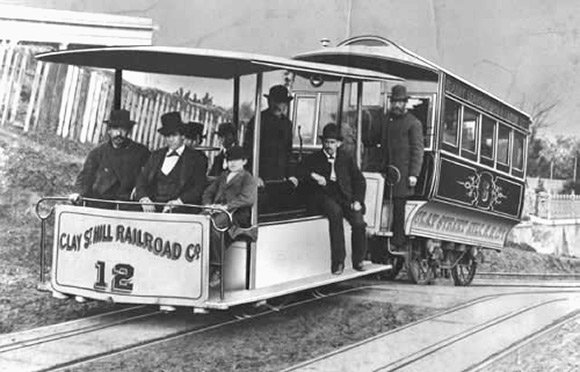Learn fascinating cable car history
Cable cars were high tech when new, revolutionizing urban transit. Here’s why.
San Francisco’s first tech boom wasn’t about silicon, but steel. Steel cable that triggered a revolution in urban transportation.
Scotsman Andrew S. Hallidie, an experienced maker of wire rope (steel cable), employed his expertise to invent the cable car on Clay Street in San Francisco, with the first run on August 2, 1873. Hallidie said he wanted to surmount hills in the City too steep for horse-drawn streetcars. (That’s him with the beard standing on the step of the cable car trailer in the photo.)
Not only could cable cars climb hills horses couldn’t, on level ground cable cars were almost twice as fast as horse-drawn streetcars. Private transit companies in numerous cities soon embraced them. In exchange for higher installation costs, they saved the considerable cost of caring for horses, and the faster speed meant more passengers and fares. New York City, Chicago, Philadelphia, Los Angeles, and Oakland were among the 29 US cities to install cable lines; London, Paris, Sydney, and Melbourne were among 11 known overseas cable lines.
Seeing the benefits of faster, horse-free urban transportation inspired other innovators. In 1888, Frank Sprague inaugurated the first practical electric streetcar line in Richmond, Virginia. Taking advantage of rapid improvements in electric motors, streetcars could run twice as fast as cable cars, and soon replaced them on flat routes, including in San Francisco.
The greatest extent of cable car routes in San Francisco, 1892. Map by Jake Berman. Click to enlarge.
So, the cable car’s reign atop the transit tech heap was brief. But on steep hills, cable cars endured because the underground cable can literally pull them up almost any grade, while the steel wheels of electric streetcars, usually powered by an overhead wire, slip on the steel tracks on steep hills.
By 1941, when cable lines in Seattle and Tacoma closed, San Francisco had the only street-running cable cars in America. The 1957 closure of a cable line in New Zealand made San Francisco’s cable cars unique in the entire world. Threatened with scrapping in 1947, cable car lovers rallied to defend San Francisco’s system and when the original installations wore out in the early 1980s, the City rebuilt its cable car network from the dirt up.
Learn more in person
The free Cable Car Museum at Washington and Mason Streets is open Tuesdays through Sundays. It’s right where the two Powell lines meet, and two blocks north of the California line. The museum occupies the mezzanine level of Muni’s historic Cable Car Barn & Powerhouse, where you can see the vintage cable winding machinery doing its job and watch the cables leave the barn underground to pull the cars. Antique cable cars, including one from Hallidie’s original Clay Street Hill Railroad, are on display as well, and there’s a shop selling souvenirs.
The free San Francisco Railway Museum, located right on the F-Market & Wharves vintage streetcar line at 77 Steuart Street, across from the historic Ferry Building (and just two blocks from the Downtown terminal of the California Street cable line), celebrates the history of cable cars as well as electric streetcars, which have been an important part of San Francisco since 1892. An integrated gift shop features unique San Francisco transit merchandise, much of it available only at the museum and its online store, which also includes hard-to-find cable car books and genuine cable car track souvenirs.
Learn more online
You can find links to interesting accounts of cable car history, threats, and personalities on this site’s Cable Car Stories page.
Most of this exclusive content comes from the nonprofit Market Street Railway’s website, streetcar.org, a treasure trove of information and stories about San Francisco’s cable cars., including:
For those looking for a wonderful cable car “rabbit hole” to burrow into, we highly recommend the detailed website of historian Joe Thompson, cable-car-guy.com. It’s filled with great stories and facts about cable car systems the world over, with special emphasis on San Francisco.
Learn more from books!
The San Francisco Public Library offers a comprehensive listing of books about cable cars, including some rare ones. Check it out!

